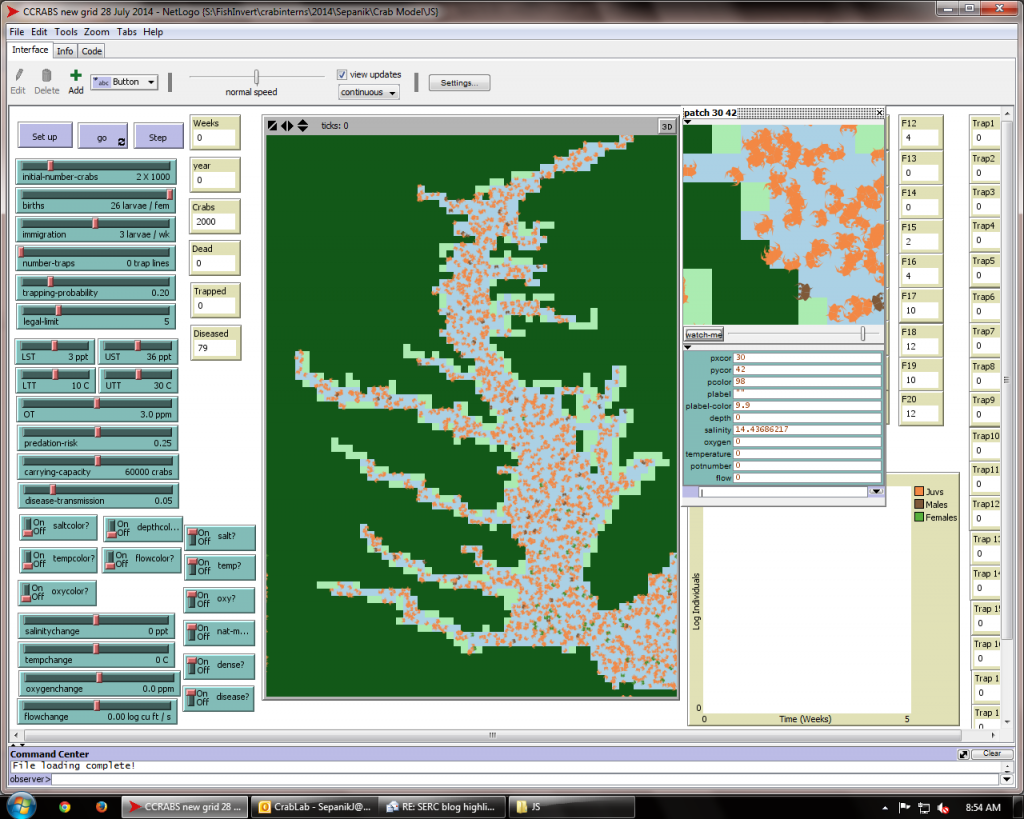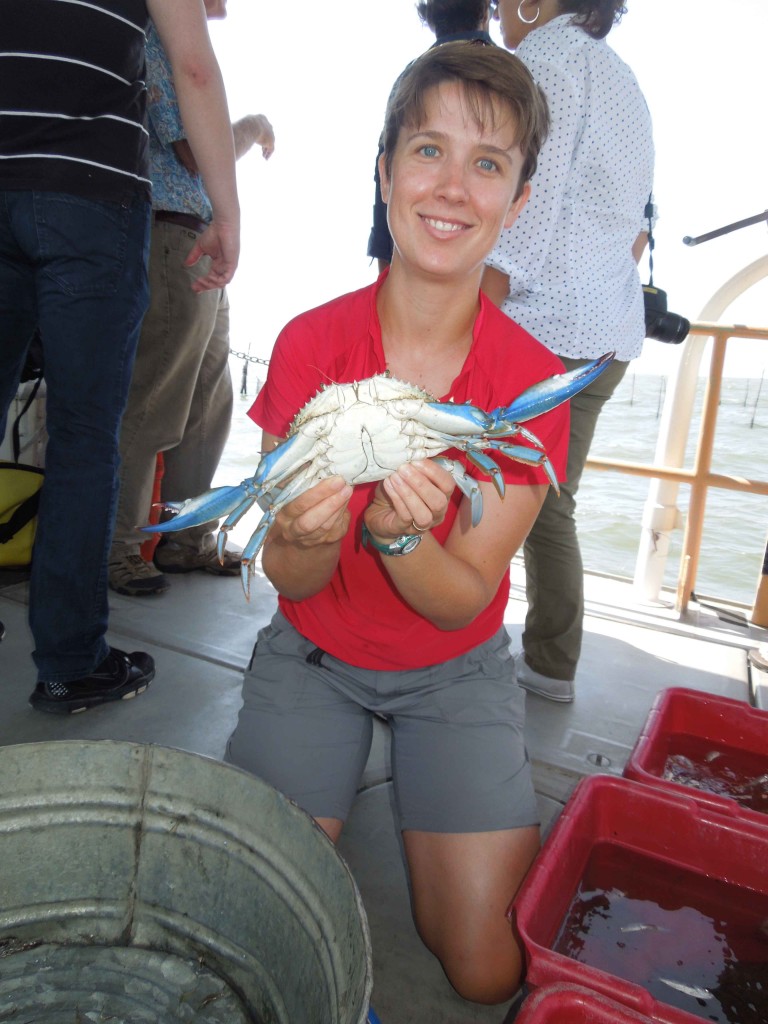by Sarah Hansen
No one disputes that blue crab numbers in Chesapeake Bay are low. There is much discussion, however, about what to do to fix the problem. Smithsonian Environmental Research Center intern Julie Sepanik is working with SERC postdoctoral fellow Matt Ogburn to develop a computer model that will help improve our understanding of blue crab population dynamics in the Bay. The model works to identify where female crabs mature in the Bay and track their migration to lower Bay spawning areas. Ultimately, they hope the model will help inform decisions about preserving habitat and restoring the population.
Right now the crabs on Sepanik’s computer screen (almost all orange for juveniles, a few brown males and a rare green female) don’t represent real, tagged crabs. Instead, their numbers are estimates of how many crabs of each sex and age should be present based on known local conditions in the Bay and crab behavior. “Later they’re hoping to validate the model with actual, real-world data,” said Sepanik. Some of the conditions that may affect crab behavior and success include salinity, depth, temperature, dissolved oxygen and fishing activity.
Sepanik is using a pixelated grid of the Bay with a total of 4,312 habitat patches. Each patch is classified as land, nursery (less than 2 meters deep), or open water, and assigned values for the various habitat conditions based on real data. Within the cells, each model crab’s fate is determined by a set of equations that account for all the habitat factors. “This is modeling the behavior at the individual level,” Sepanik said, “So you have a crab over here in the Potomac that’s experiencing different environmental factors than a crab down here at the mouth of the Bay.”
When Sepanik clicks a button, the virtual crabs begin to move across the screen. Females migrate toward the mouth of the Bay. Some juveniles travel up north to the tributaries. In the winter, motion comes almost to a halt. How much the virtual crab population grows after one or five years depends on how she has dialed up or dialed down the variables.

Screenshot of Sepanik’s blue crab model. Orange dots are juvenile crabs, brown are males, and greens are female. (Julie Sepanik/SERC)
Sepanik wants to know where in the Bay females reach maturity by molting for the last time and, in particular, where females who successfully spawn matured. With that knowledge, managers will have a better idea where to focus limited resources for helping blue crabs. If many of the females who spawn matured in the same place, that nursery habitat may be especially important to protect. On the other hand, if most females who mature in another location do not survive to spawn, managers could examine activities at that location to figure out why.
But results from the model are more powerful if real data are used to validate it. So, if Sepanik’s results turn up locations with potentially high or low female spawning success rates, that’s where other members of SERC’s Fish and Invertebrate Ecology Lab, affectionately known as the “Crab Lab,” will go next to tag crabs. If the real-world data corroborate Sepanik’s findings, that makes the results all the more convincing and, importantly, makes a stronger argument for policymakers to take action based on the findings.
But the model’s not quite there yet. “My goal is to make sure that the movement of the crabs is working before I leave,” Sepanik said. Female crabs move south and to areas of higher salinity to breed. She wants to make sure the model reflects those tendencies accurately.
As in any ecological system, there are lots of factors at play. “You can tease them out a little bit by changing them in the model and seeing what happens, once you have the model working correctly,” said Sepanik. So, once the model is reliable, information it provides may further shape efforts to rebuild healthy blue crab populations.
But this isn’t all Sepanik has been doing this summer. “I enjoy the modeling, but it’s nice to get out in the field a little bit,” she said. She’s helped with trawling, seining, and crab and fish tagging, among other outdoor research activities. It’s a change of pace from when she worked at the Bureau of Alcohol, Tobacco, Firearms and Explosives using Geographic Information Systems (GIS) to find where guns involved in crimes had been bought. “It was a really interesting job,” she said, “You can apply GIS to almost any subject matter.”
Sepanik is trained in GIS, which she uses for the crab modeling project, but her passion lies in coastal ecology. Her master’s thesis, which she plans to finish this fall at George Mason University in Virginia, focuses on change in salt marshes related to sea-level rise.
Her time at SERC has been well spent, though. Refining the model is a small way to help crabs rebound to healthy population sizes. And it’s set Sepanik’s course toward a career in environmental science. That would come across as a win-win in any discussion.


